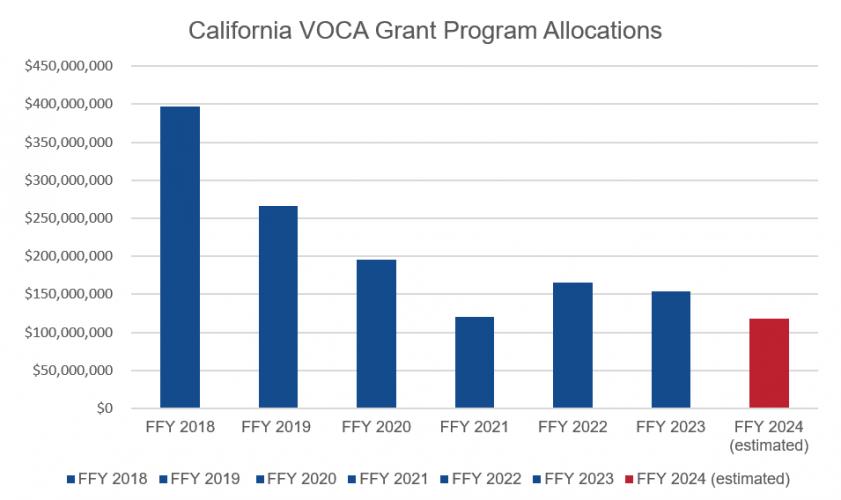CSAC Urgently Needs to Hear from Your County: Substantial VOCA Cuts Expected in 2024-25
August 17, 2023
Through the federal appropriations process, the United States Congress plays an influential role in setting an annual cap on available funds for the Victims of Crime Act of 1984 (VOCA). This cap fluctuates and is determined in the federal spending bill. As a formula grant program, the VOCA Victim Assistance Formula Grant Program supports 30 Governor’s Office of Emergency Services (CalOES) programs, including more than 800 grant sub-awards, and 400 unique agencies – many of which are California county agencies and departments.
|
FY 2023-24 Programs |
|
|
Non-Competitive Programs |
Competitive Programs |
|
County Victim Services |
Legal Assistance |
|
Victim Information & Notification Everyday |
Human Trafficking Advocacy |
|
Victim Notification |
Elder Abuse |
|
Victim Services Information & Enhancement |
Innovative Response to Marginalized Victims |
|
Victim/Witness Assistance |
Child Abuse Treatment |
|
Victims Legal Resource Center |
Bullying & Violence in School Advocacy |
|
Child Sexual Abuse Treatment |
Supervised Visitation |
|
Court Appointed Special Advocates |
Transitional Housing |
|
Homeless Youth & Exploitation |
Child Advocacy Center |
|
Native American Child Abuse Treatment |
Underserved Child & Youth Advocacy |
|
Domestic Violence Assistance |
Sexual Assault Response Team |
|
Rape Crisis |
Victim Advocacy in Detention Facilities |
|
Native American Tribal Court Advocate |
Unserved/Underserved Victim Advocacy & Outreach |
|
Youth Emergency Telephone Referral Network |
Specialized Housing |
|
Domestic Violence Housing First |
|
Significant Funding Reductions Anticipated
The proposed United States House and Senate Commerce-Justice Science funding bills are expected to set the VOCA Victim Assistance Formula Grant Program cap at $1.2 billion in federal Fiscal Year 2024, which is about 37 percent lower than current year funding of $1.9 billion. The United States Crime Victim Fund which funds VOCA grants is supported with federal criminal fines and penalties. In turn, grants money is distributed to states through a statutorily established annual distribution process. In proposing this cap reduction, Congress noted insufficient annual deposits, uncertainty about future receipts, and the long-term stability of the VOCA Fund.
CalOES anticipates a significant reduction to the California VOCA Victim Assistance Formula Grant Program. California’s VOCA Victim Assistance Formula Grant Program is projecting funding of approximately $105.8 million to $131.1 million in federal Fiscal Year 2024. This represents an approximate $22.7 million to $48 million reduction from the current year.
What does this mean for California Counties?
The CalOES Victim Services Branch recently held a VOCA Steering Committee meeting, noting that $262.2 million is needed to sustain current funding levels. With anticipated federal funding of only approximately $105.8 million to $132.1 million, CalOES is already planning for drastic cuts. Among the options being considered is a possible 40 percent cut across-the-board to all programs, or a 50 percent cut to all competitive programs.
Next Steps – We Need to Hear from your County ASAP
CSAC is advocating at the federal level for a higher VOCA cap for federal Fiscal Year 2024 — both Congress and the Biden Administration. We are in urgent need of your county’s assistance in providing data or practical examples illustrating how reduced VOCA funding would impact California counties. They need to understand what the reductions mean on the ground. Your county’s input will be particularly helpful in advocating for an increased cap and ultimately benefit crime victims in your county. If you have any data or examples to share, please email Brian Cote at bcote@counties.org by August 25, 2023. Additionally, if you have any questions or require additional information, please do not hesitate to reach out.









































